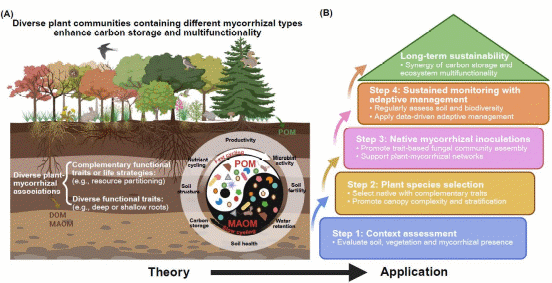As the world grapples with the intertwined challenges of global forest degradation and climate change, traditional forest restoration approaches have shown critical shortcomings. These approaches, which have long focused exclusively on aboveground carbon storage, often result in sluggish soil carbon recovery and an insufficient restoration of full ecosystem functionality.
To address this gap, an international study led by the South China Botanical Garden of the Chinese Academy of Sciences, in collaboration with research partners from Germany, the United States, the Czech Republic, the Netherlands, and Italy, has introduced a game-changing "Plant-Mycorrhiza Synergy" framework, with findings published in the journal Trends in Ecology & Evolution.
By synthesizing global datasets on forest biodiversity, the research team uncovered distinct yet complementary roles played by the two most dominant types of mycorrhizal fungi-symbiotic organisms that form partnerships with plant roots-each contributing uniquely to soil health and carbon storage.
Arbuscular Mycorrhizal (AM) fungi, when paired with their host plants, act as "deep carbon engineers." These plant-fungus partnerships generate high-quality leaf litter, root exudates (organic substances released by plant roots), and extensive underground fungal networks, all of which drive the formation and stabilization of Mineral-Associated Organic Matter (MAOM) in deeper soil layers. This process not only enables long-term carbon storage but also enhances soil water retention and fertility, laying a foundation for sustained ecosystem health.
In contrast, Ectomycorrhizal (ECM) fungi and their associated plants function as "surface-active stewards." The plants in these partnerships produce litter that decomposes slowly, while the fungi compete for nitrogen in topsoil-actions that boost the accumulation of Particulate Organic Matter (POM) in upper soil layers. POM is critical for maintaining soil structure, supplying nutrients to plants and microbes, supporting microbial activity, and sustaining short-term ecosystem productivity.
The study's key insight lies in how these two fungal types interact in diverse mixed forests: AM fungi-facilitated deep MAOM ensures long-term carbon stability, while ECM fungi-driven surface POM sustains ongoing ecosystem vitality. This dual mechanism not only significantly increases total carbon storage in forest soils but also concurrently enhances nutrient retention, drought resilience, resistance to environmental disturbances, and overall biodiversity.
The research team created a practical "Assess-Select-Inoculate-Monitor" workflow for real-world restoration projects. First, they assess local conditions-climate, soil, vegetation, and mycorrhizal type (AM or ECM). For example, AM systems prevail in tropical regions, while mixed AM/ECM types occur in temperate and boreal zones. Next, species are chosen for diverse root depths, growth rates, and a mix of AM- and ECM-associated plants to optimize resources and carbon distribution. Mycorrhizal inoculation with native, efficient fungi helps rebuild soil microbiomes, improving plant survival and stress tolerance. Finally, adaptive monitoring tracks key indicators like the POM/MAOM ratio and biodiversity, allowing managers to refine strategies as conditions change.
The framework's validity is supported by SCBG's 60-year tropical coastal forest restoration project, where mixed forests established using principles of plant-mycorrhiza synergy showed approximately 40% higher soil carbon storage compared to monoculture plantations, along with significant recovery of local biodiversity.
This research offers a critical "belowground solution" to advance the UN's Kunming-Montreal Global Biodiversity Framework, a landmark agreement aimed at halting and reversing biodiversity loss by 2030.

Conceptual framework for synergistic soil carbon and ecosystem restoration via plant-mycorrhizal integration. (Imaged by LI Tengteng et al.)






